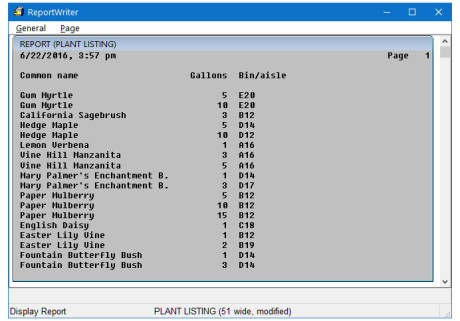ReportWriter creates columnar, ad-hoc reports that are organized according to your specifications. You specify which columns will appear in your report, as well as how the data will be arranged and sorted.
When defining a new report, you must first tell ReportWriter which files to get data from. Then, you can select the fields that contain the desired information; each field becomes a column in the report. ReportWriter shows you the basic layout of your report as you select each field. You can easily change the order and position of the fields you have selected, as well as their column headers and the way they are displayed.
|
|
Powerful selection operations enable you to display only the information that you want in your report. For example, you may want a report that contains only customers in California who have more than five employees, or patients under 12 years old who have not been examined for a year.
You can sort your report on up to 10 categories. (The report in figure 1, for example, is sorted according to gross profit, in descending order.) For each sort category, you can also specify that a page break and subtotal will occur when the value in that category changes, to break your report into easily readable blocks of data.
In addition to the existing data fields you select, ReportWriter enables you to create your own temporary fields for use in your report. You can define five types of temporary fields.
- A text field contains a text constant (for example, an asterisk or the words “past due”), which can be printed when necessary.
- A calculation field defines a mathematical computation, which is evaluated for each set of data.
- A question field contains information supplied by the person running the report in response to a question or prompt (for example, you might prompt for starting and ending dates so that the report can include only transactions that occurred between those dates).
- An environment field obtains static data from the system (for example, the current date) when the report is run.
- A subtotal access field gives you access to a field’s current total at any break point in the report.
Once created, temporary fields can be printed, sorted on, used in other temporary fields, or used in a selection operation. See Using Temporary Fields for more information.
ReportWriter enables you to specify the header and footer that will be printed on each page of the report, as well as the header and footer for the entire report. In addition, you can include the date and page number at the top of each page, specify whether your report will merely summarize the data or include detailed information, and change the page size or the number of blank lines between report entries.
At any time, without leaving the function you’re in, you can view the current design of the report you’re defining. A ruler at the top of the screen lets you verify that your text is placed exactly where you want it.
Once your report is complete, you can display it on the screen, print it, or save the data in a file. ReportWriter stores your report definition, so you can run the same report again or modify it to create a similar report.

